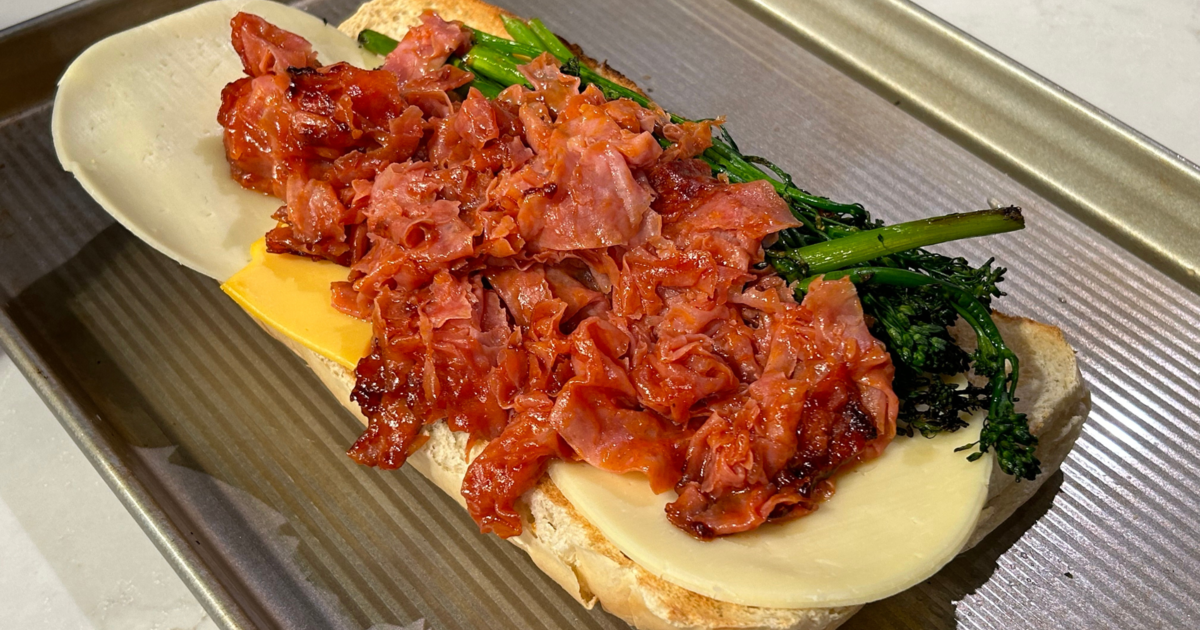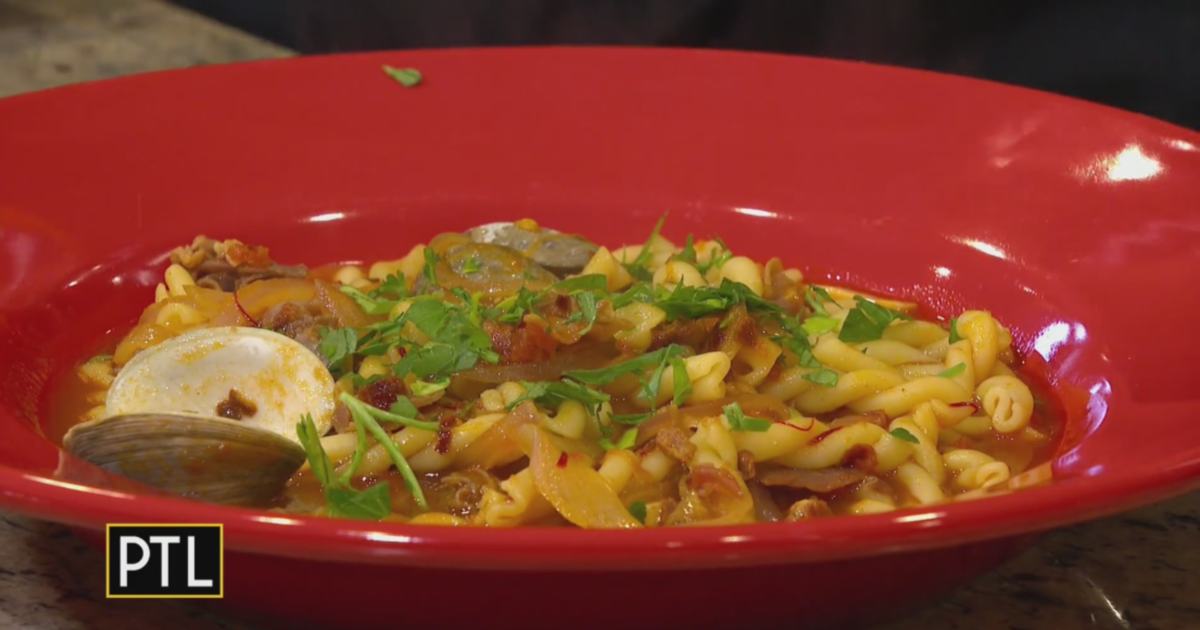Chef Bill Fuller's Recipe: Soba Duck Ramen
Chef Bill Fuller stopped by PTL to show off these delicious twist on ramen!
Soba Duck Ramen
Serves 4
- 2 ea. Pekin ducks, butchered and processed to produce:
- Rendered Duck Breasts (4)
- Braised Duck Legs (4)
- Duck Broth
- 2 C. Sliced Napa cabbage
- 1 Tbs. Neutral oil
- 1 tsp. Minced garlic
- 1 tsp Minced ginger
- 8 oz. Fresh ramen noodles – may substitute wheat spaghetti
- ¼ C. Finely julienned fresh ginger
- ¼ C. Finely julienned radish
- 1 C. Mung bean sprouts
- 4 ea, Poached eggs
- Chef Chow's Hot Sauce
1. Prepare ducks as described below.
2. Bring 4 q. of salted water to a boil
3. Heat oil in a medium sauté pan. Add ginger and garlic and cook for 30 seconds or until aromatic.
4. Add Napa cabbage and season with salt and pepper. Cook until slightly wilted. Reserve.
5. Cook noodles until done but not soft. Strain and place in equal parts in the bottoms of 4 large bowls.
6. Cover well with broth.
7. Around the bowl, atop the noodles, place piles of Napa cabbage, bean sprouts, fanned sliced duck breast, and pile of braised duck meat
8. Place poached egg in the center of each bowl.
9. Place a small pile of julienned radish and julienned ginger atop egg.
Duck Butchery:
1. Clean out duck cavity. Reserve heart, gizzard, and neck. If desired, reserve liver for a separate use.
2. Lay duck on back. Cut skin between leg meat and breast meat. Follow skin along edge of leg meat down to back. Turn duck onto breast.
3. Cut around 'oyster' of the muscle where the thigh attaches to the hip and break leg free of body at joint. Follow bone with your knife to the back of carcass. Repeat on other leg. Trim fat on legs to fit meat. Keep trimmings to render (see below).
4. Place duck on back with head end towards you. Make two cuts the length of the breastbone and gently pull meat back. With your boning knife, follow wish bone down either side of the neck cavity.
5. Turn duck tail towards you. Finish freeing breast from ribcage and wishbone.
6. Place breasts skin side down. Trim around breast to edge of meat. Trim flat tendon off meat. Keep fat trimmings to render (see below).
7. Turn breast over. Score evenly in a1/4" checkerboard pattern cutting into but not through skin.
Leg Cooking:
1. Season both sides of leg with salt, pepper, and chopped fresh thyme. If you have fresh bay leaves, lay one against the flesh side of each leg. Lay skin side up in shallow baking pan. Allow to marinate overnight.
2. Drain any liquid that comes off the legs.
3. Place in 375 oven and cook until skin is lightly browned, about 45 minutes. Pour off rendered fat and reserve for another use.
4. Add enough stock to half cover leg (about up to the skin) and return to oven. Reduce temperature to 325 and cook until very tender, about an hour. (If stock nearly reduces dry, replenish with a little water or stock. When done, leg should be glazed by the stock and very tender.)
5. Remove and reserve. Do not discard braising liquid. Strain well and add to duck broth.
6. Remove meat from bones and reserve.
Breast Cooking:
1. Heat an iron skillet on medium heat. Season breasts with salt and pepper. Place skin side down and cook slowly, rendering the fat. Pour off fat as it accumulates, reserve.
2. When skin is browned and crispy and has begun to shrink from the edges of the breast meat, turn breast and cook to desired temperature – medium is best.
3. Remove from skillet and allow to rest for 10 to 15 minutes.
4. Slice thinly. Reserve.
Duck Broth
- 2 ea. Duck carcass
- ½ # Dried shiitake mushrooms
- 1 large onion, halved and blackened in a skillet
- 1 Small piece of kombu
- ½ C. Ginger, rough chopped
- 2 head Garlic, sliced in half
- 1 tsp. Black peppercorns
- ½ C. Salt
- ½ C. Soy sauce
1. Trim excess fat from carcass. Place carcass, neck, and organs on a sheet pan. Place in 450 oven. Roast until bones are well browned.
2. Drain fat (reserve) and place bones into stockpot. Place shiitakes, onions, kombu, ginger, and garlic in pot.
3. Cover with cold water (approx. 2 gallons) and place on stove.
4. Bring to a boil and reduce heat to a minimal simmer. Skim off all fat and foam. Cook at least 4 hours, preferably overnight.
5. When done, skim fat and strain stock through a coarse mesh strainer. Strain again with a fine mesh strainer. Discard bones.
6. Season with salt and soy sauce.
Chef Chows Hot Sauce
- 1 # Dried thai chilies, ground in blender
- 1 C. Sake (enough to cover chilies)
- 1 Tbs. Salt
- 3 C. Soybean oil
- ½ C. Sliced scallion rings
- 3 Tbs. Sliced garlic
- 3 Tbs. Sliced ginger
- Zest of ½ lemon
1. Soak chilies in sake & salt for 1 hour.
2. Combine remaining ingredients in all clad. Heat oil SLOWLY over medium heat until oil absorbs all flavors, approximately ½ hour.
3. Increase heat until just before oil smokes.
4. Turn off heat & add oil (while straining) one ladle at a time, to the sake/chili mixture. DO this in a well-ventilated area!
5. Cover and cool



